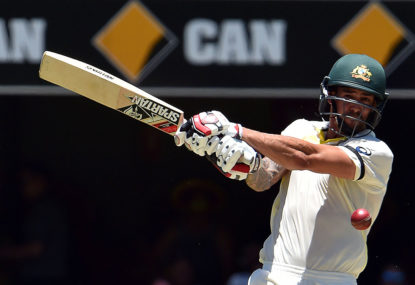Expert

A batting bunny such as Jackson Bird must be a demonstrably better bowling option than a multi-skilled player like James Pattinson or he can’t be selected ahead of him in Tests. This is the new reality.
“Just pick the best four bowlers, ignore their batting ability.” How often have you heard this viewpoint uttered by a cricket follower, even to this day? It is terribly outdated.
A distant memory is the era when tail enders had leeway to simply heave the willow. As cricket has become more professional, bowlers have been afforded better batting coaching and more time to work on this skill.
Tail-end runs now frequently decide not just single Tests but whole series. India’s weak tail may well have cost it the first Test of the series against Australia, while a strengthened lower order helped it avoid defeat in both the third and fourth matches.
Across the four-Test series, Australia’s bowlers ran amok with the bat, demoralising the touring team. Together, Mitchell Johnson, Ryan Harris, Mitchell Starc, Josh Hazlewood and Nathan Lyon made 375 runs at 37 for the series.
By comparison, the Indian tail was brittle, with Ravi Ashwin, Bhuvneshwar Kumar, Ishant Sharma, Mohammed Shami, Varun Aaron, Umesh Yadav and Karn Sharma combining for 295 runs at just 16.
The likes of Ishant, Yadav, Aaron and Karn were virtual shadows with the bat, with the first three historically inept at the crease. From a combined 15 innings for the series they returned 65 runs at an average of 6.
An Indian tail which includes Ishant, Yadav and Aaron would plant a broad smile on the face of any foe. The strength, or otherwise, of a side’s lower order has a significant psychological impact on the opposition attack.
During this series, when Australia got India four or five down they surely received a shot of adrenaline, aware that once they accessed the lower order the kill would be swift. Whereas India’s bowlers, even with six or seven wickets in the bank, must have felt as though a lot of robust work remained to dismiss their foes.
On Day 5 at the SCG, India were six wickets down still needing to survive 19 overs, including 10 against the second new ball. With the tail they fielded in the first three Tests, which Australia’s attack scythed through with ease, they might not even have lasted long enough to catch sight of the shiny ball.
This time, however, they had two gifted lower order players in Ashwin and Kumar. The former is a genuine bowling all-rounder and the latter is close to justifying such a tag.
Ashwin made only one run, but at least chewed up more than half an hour in doing so. Kumar then coolly compiled 20 not out to help his side avoid a 3-0 series scoreline.
At the MCG Ashwin played that same role, staying at the crease with MS Dhoni for 45 minutes in thwarting Australia’s push for victory. In both matches, the tail saved India, just as Australia’s has done repeatedly in recent years.
The impact of Australia’s lower order during last summer’s Ashes was pronounced and has been well documented.
Spinner Lyon is comfortably the worst batsmen in Australia’s first-choice XI yet even he can do a role for his side. His Test batting mark of 15 is not far behind that of Shane Warne, who averaged 17 while batting at eight for a good portion of his Australian career.
Veteran quicks Johnson Ryan Harris average 23 and 22 with the bat respectively. Meanwhile, emerging Australian pacemen Pattinson and Starc have resembled specialist batsmen at times during their brief Test careers while both averaging 30. Hazlewood has had fewer opportunities to pile up runs but on debut unfurled several languid strokes on his way to 32 not out.
Much has been written about Darren Lehmann’s so-called 140 kilometres an hour rule, and the fact that it may be hindering bowlers like Bird and South Australian swing bowler Chadd Sayers.
It cannot be overlooked, however, that aside from giving up 10 kilometres an hour or more to the likes of Starc, Pattinson and Hazlewood, that pair also offer far less with the bat.
In line-ball decisions on the makeup on a Test XI, surely the selectors will favour the bowler who possesses greater batting gifts. So they should. A capable tail is a weapon.